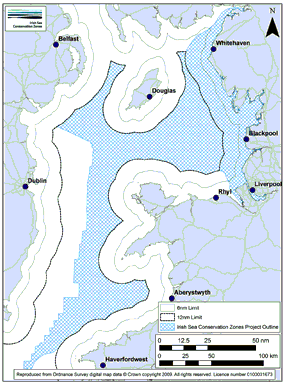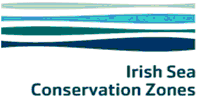The Irish Sea Conservation Zones (ISCZ) will help secure a healthy and productive future for the coast and waters of the Irish Sea.
Over the next few years, parts of the Irish Sea will be given environmental protection as the UK government is committed to establishing a network of Marine Protected Areas by 2012 – as part of the Marine Bill.
The purpose of the ISCZ is to help the people who use the Irish Sea make recommendations to the government. It is the first time this stakeholder led process has been practised in the UK to help identify marine areas of protection.
The recommendations from users of the Irish Sea will form an essential part of the government’s decision as to which parts of the Irish Sea will be protected and how. The recommendations will go to government in June 2011.
 The Irish Sea separates the islands of Ireland and Great Britain. Its coastlines run from South Wales up to Liverpool, Morecambe Bay and Cumbria on the Northwest coast of Great Britain and from Belfast down to the Southeast coast of the Republic of Ireland as well as including the Isle of Man.
The Irish Sea separates the islands of Ireland and Great Britain. Its coastlines run from South Wales up to Liverpool, Morecambe Bay and Cumbria on the Northwest coast of Great Britain and from Belfast down to the Southeast coast of the Republic of Ireland as well as including the Isle of Man.
The Irish Sea has lots of different habitats including honeycomb reefs made up of living worms and muddy beds home to sea urchins, Dublin Bay prawns and brittlestars. Other landscapes include rocky reefs, sea grass beds, and gardens made up of plant-like animals called sea pens.
The Irish Sea is also home to important species such as sharks, whales, dolphins and porpoise, as well as the rare and endangered pink sea fan.
The Irish Sea is of great financial importance as it hosts the Port of Liverpool – a major container port – as well as oil and gas drilling platforms. The waters also support important fish and shellfish fisheries.
The climate and shallow water also make the Northwest coast of the Irish Sea an excellent location for the development of wind farms, producing valuable renewable energy.
Rowan Byrne, project manager of the Irish Sea Conservation Zones, said: “We will only achieve our aims by really engaging a broad range of people who use the Irish Sea.
“We want to talk to everyone and anyone who uses, enjoys or makes their living from the Irish Sea, whether they are anglers, divers, businesses, commercial fishermen or conservation groups. We need them to share their knowledge and expertise so that we can help them recommend a network of potential Marine Conservations Zones to the government.
“These Marine Conservation Zones will need to meet scientific criteria, minimise social and economic costs and maximise benefits to society. We will be working with an independent facilitator to ensure that each group is fully represented.”
The network of Marine Protected Areas in England will be made up of five different types of site:
• Marine Conservation Zones
• Sites of Special Scientific Interest
• Special Areas of Conservation
• Special Protected Areas
• Ramsar Sites
Together these sites will provide more benefits than one single area would. The network will conserve rare, threatened and representative species and habitats to conserve or improve biodiversity.
The Regional Marine Conservation Zones Projects have been set up by Natural England and the Joint Nature Conservation Committee to identify and recommend Marine Conservation Zones to Government.
 There are four regional projects in England and the ISCZ is hosted by Envirolink, a not-for-profit organisation, which supports the environmental technology sector in the Northwest and is based in Warrington.
There are four regional projects in England and the ISCZ is hosted by Envirolink, a not-for-profit organisation, which supports the environmental technology sector in the Northwest and is based in Warrington.
For further information on the Irish Sea Conservation Zones visit www.irishseaconservation.org.uk
To get in touch with the Irish Sea Conservation Zones contact info@irishseaconservation.org.uk










